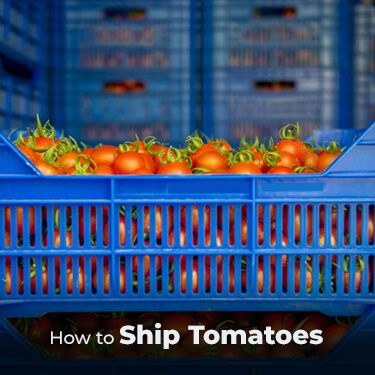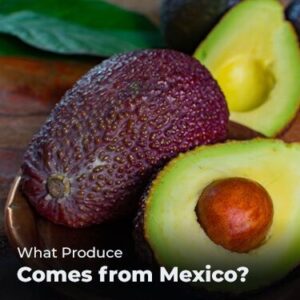
Por
 Copiar URL al Portapapeles
Copiar URL al Portapapeles
The crop has grown and you’re ready to turn all those meticulously grown tomatoes into hard-earned money. But shipping tomatoes from Mexico takes some careful planning to ensure the best-looking, tastiest product reaches the stores. Transporting your tomatoes incorrectly could make the final product less attractive or, worse, cause them to be damaged or rot.
The processes for shipping tomatoes from Mexico can be strict when dealing with agencies such as U.S. Customs and Border Patrol (CBP), and the U.S. Food and Drug Administration (FDA). There is also the Food Modernization Safety Act (FMSA) which was implemented in 2017 and focuses on food safety when transporting produce.
With the following tips, shipping tomatoes from Mexico will be easier and allow more profits to end up in your pocket.
Table of Contents
 What Produce Comes from Mexico?
What Produce Comes from Mexico?While this article will deal strictly with how to ship tomatoes, it’s important to know that the Spanish-speaking North American country is a super-producer of a variety of fruits and vegetables. In turn, a sizable chunk of this produce ends up across Mexico’s northern border.
The United States alone imported $6.7 billion in vegetables in 2018, the leader of which is tomatoes at $2.3 billion. Mexico also sent $1.7 billion in avocados to America as well. In all, 39 percent of the vegetables that the United States imports come from Mexico. Also, $5.3 billion of fruits and nuts were sent from Mexico to the U.S.
Here is a list of the major vegetables Mexico exports to America:
Fruits, as previously mentioned, are a huge export by Mexico to the U.S.
Suffice to say, there is a lot of time, energy and money invested on both sides of the border to get this produce moved in a safe and efficient manner.
Tomatoes are generally consumed in two different ways: fresh tomatoes that would be bought at a store or tomatoes that are used for canning and sauces. This is very important because it will dictate which stage you harvest the tomatoes at.
For store-bought tomatoes, those are picked while they are still green and ripen en route to the store using a spray of the vegetable’s natural ripening hormone called ethylene. Tomatoes used for canning or sauces will be picked while they are red and already ripe because they are generally canned or crushed to make sauces within six hours of being picked.
Next, for tomatoes that will be purchased in stores, making sure the temperature is right during shipping is essential to keeping the vegetable tasting its best and also reducing the amount of spoilage before hitting the produce department. The optimal temperature range to ship tomatoes at is between 55 and 60 degrees Fahrenheit. If you ship them lower than 55 degrees, you risk low-temperature spoilage and higher than 60 degrees could accelerate the ripening process, which could also cause them to spoil faster than they otherwise would.
Also, tomatoes don’t do well with large, sudden fluctuations in temperature. For example, if the tomatoes were being shipped in a low-humidity environment of 64 degrees and were suddenly exposed to a high-humidity temperature around 86 degrees, condensation would begin to occur on the surface of the tomato and impact the quality of the vegetable’s taste.
Tomatoes are also sensitive to contamination. The trucks must be hygienically cleaned before the tomatoes are loaded.
Tomatoes are often packaged in open or closed fruit crates, boxes, tubs, cartons and trays and are predominantly transported from Mexico to the U.S. by truck. Tomatoes enter and leave the U.S. at many border cities, including Laredo. Tomatoes can also be packed directly on top of each other without being bruised because of years of breeding that have left the vegetables with thick skin. Also, tomato varieties have uniform size, which allows them to be packed together more easily.
The vegetable requires particular temperature, humidity and ventilation conditions, so a climate-controlled truck with the correct amount of airflow and proper level of humidity is a must. If any of the conditions are off, it can lead to accelerated ripening, rotting or alter the taste of an otherwise good tomato.
 Regulations for Shipping Tomatoes From Mexico
Regulations for Shipping Tomatoes From Mexico Here comes the most complicated part of the process: all the regulations that need to be meticulously followed in order to ensure your fresh tomatoes can make it into the U.S. for sale.
The first order of business is making sure to get all your required paperwork filled out in a timely manner. A customs broker can really help during this process. They are licensed by the CBP and can help with essential tasks like arranging duties to be paid, preparing and filing the customs entries, taking steps to help release the goods from CBP control and more.
As far as the safety and regulations portion goes, first up is the Food Modernization Safety Act or FMSA. Implemented in 2017, the act involves ensuring food safety while produce is in transport. The FDA makes sure the FMSA is being properly carried out and holds vehicles moving food to stringent guidelines.
Requirements under the FMSA:
All of the FDA requirements for importing food products into the U.S. can be found here. Both APHIS and the FDA determine the viability of food imports, with the CBP enforcing those laws. The importer must have the shipment inspected for quality and grade by the AMS. The CBP will not release the food without prior notice that has been filed with the FDA.
R+L Global Logistics and its qualified network of premium carriers in Mexico provide you with secure door-to-door Less than Truckload (LTL) and Full Truckload (FTL) services. We cover the entire Mexican territory and move cargo across all major US/Mexico border gateways. We also move intra-Mexico shipments.
Our Mexico logistics experts and their knowledge of the US/Mexican border operations keep your cargo moving seamlessly and are the perfect way to ship tomatoes from Mexico. We work closely with all parties of the logistics process to facilitate:
Our Mexico Logistics experts are trained to proactively manage the complexity of international shipping and effectively translate to our customer the various requirements in relation to shipping documentation, the clearance process, trade agreements, and import programs. If you have any questions about maquiladora tax benefits or you’re ready to schedule your tomato shipment from Mexico, contact us today. We’ll make the process of shipping tomatoes from Mexico easy and hassle-free.
 Copiar URL en el Portapapeles
Copiar URL en el Portapapeles
